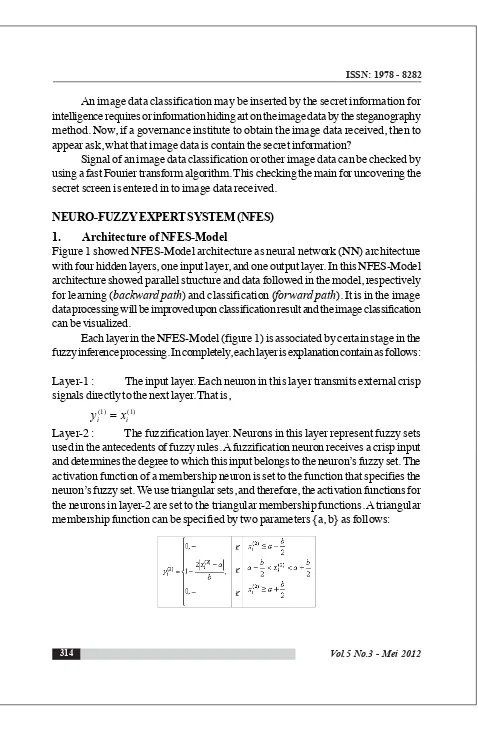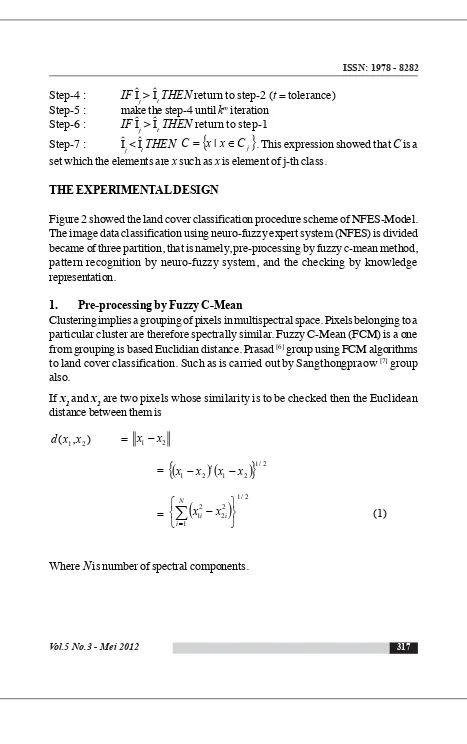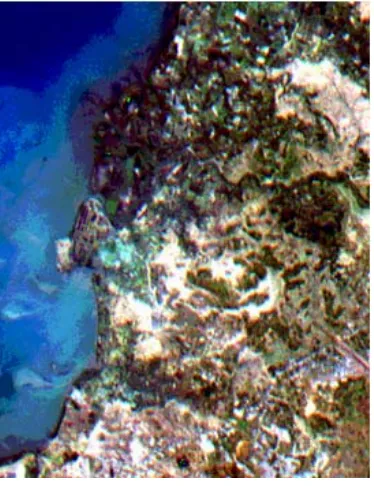SIGNAL CHECKING OF STEGANO
INSERTED ON IMAGE DATA
CLASSIFICATION BY NFES-MODEL
M. Givi Efgivia1
Safaruddin A. Prasad2
Al-Bahra.LB3
e-mail : [email protected], [email protected], [email protected].
Diterima : 19 Desember 2011 / Disetujui : 28 Desember 2011
ABSTRACT
Abstract. In this paper, we propose an identification method of the land cover from remote sensing data with combining neuro-fuzzy and expert system. This combining then is called by Neuro-Fuzzy Expert System Model (NFES-Model). A Neural network (NN) is a part from neuro-fuzzy has the ability to recognize complex patterns, and classifies them into many desired classes. However, the neural network might produce misclassification. By adding fuzzy expert system into NN using geographic knowledge based, then misclassification can be decreased, with the result that improvement of classification result, compared with a neural network approximation. An image data classification result may be obtained the secret information with the inserted by steganography method and other encryption. For the known of secret information, we use a fast fourier transform method to detection of existence of that information by signal analyzing technique.
Keywords: steganography, knowledge-based, neuro-fuzzy, expert system, signal analyzing.
1 . Dosen Pengajar STMIK Muhammadiyah Jakarta Jl. Tebet Barat XI No. 8-9 Tebet-Jakarta
2 . Dosen Pengajar Fisika, FMIPA, UNHAS, Makassar
Jl. Perintis Kemerdekaan Km. 10, Makassar 90245 Telp. 0411-586200 3 . Dosen Jurusan Manajemen Informatika,AMIK Raharja Informatika
INTRODUCTION
Neuro-fuzzy expert system model (NFES – Model) can be divided into two sub-systems which consist of neuro-fuzzy system and expert system. Neuro-fuzzy system is a combination of neural networks and fuzzy systems, where each has independent areas. The connections to each other are merely marginal but both bring benefit for the solution of many problems.
Lotfi A. Zadeh introduced the concept of fuzzy sets in 1965. In 1974, E.H. Mamdani invented a fuzzy inference procedure, thus setting the stage for initial development and proliferation of fuzzy system applications. Logic programming also played an important role in disseminating the idea of fuzzy inference, as it emphasizes the importance of non-numerical knowledge over traditional mathematical models
[4].
Expert systems are computer programs which use symbolic knowledge to simulate the behavior of human experts, and they are a topical issue in the field of artificial intelligence (AI). However, people working in the field of AI continue to be confused about what AI really is proposed by Schank [6]. In other words, there are
attempts to conf properties (or attributes) to a computer system under the guise of AI, but the practitioners find difficulty in defining these properties! It is generally accepted that an expert system is useful when it reaches the same conclusion as an expert [7].
The most recent wave of fuzzy expert system technology uses consolidated hybrid architectures, what we call Synergetic AI. These architectures developed in response to the limitations of previous large-scale fuzzy expert systems.
The NFES-Model is developed and implemented to analyze of land cover classification on the field of Maros District on South Sulawesi Province, Indonesia. The fuzzy logic is used to analyze of remote sensed data for land cover classification since Maros District is complex geography, the remotely sensed image has various geometrical distortions caused by an effect the complex earth surface, such as the shadow of hills.
Remotely sensed image data sampled from a satellite includes specific problems such as large image data size, difficulty in extracting characteristics of image data and a quantity of complex geographical information in a pixel due to its size of 30 m2. In the past, we have used a statistical method such as a maximum likelihood
An image data classification may be inserted by the secret information for intelligence requires or information hiding art on the image data by the steganography method. Now, if a governance institute to obtain the image data received, then to appear ask, what that image data is contain the secret information?
Signal of an image data classification or other image data can be checked by using a fast Fourier transform algorithm. This checking the main for uncovering the secret screen is entered in to image data received.
NEURO-FUZZY EXPERT SYSTEM (NFES)
1. Architecture of NFES-Model
Figure 1 showed NFES-Model architecture as neural network (NN) architecture with four hidden layers, one input layer, and one output layer. In this NFES-Model architecture showed parallel structure and data followed in the model, respectively for learning (backward path) and classification (forward path). It is in the image data processing will be improved upon classification result and the image classification can be visualized.
Each layer in the NFES-Model (figure 1) is associated by certain stage in the fuzzy inference processing. In completely, each layer is explanation contain as follows:
Layer-1 : The input layer. Each neuron in this layer transmits external crisp signals directly to the next layer. That is,
) 1 ( ) 1 (
i
i x
y
Figure-1. The architecture of NFES-Model
Layer-3 : The fuzzy rule layer. Each neuron in this layer corresponds to a single fuzzy rule. A fuzzy rule neuron receives inputs from the fuzzification neurons that represent fuzzy sets in the rule antecedents. For instance, neuron R1, which corresponds to Rule-1, receives inputs from neurons PR1, PR2, and PR3.
In a neuro-fuzzy system, intersection can be implemented by the product operator. Thus, the output of neuron I in layer-3 is obtained as:
) 3 ( )
3 ( 2 ) 3 ( 1 ) 3 (
... ki i
i
i x x x
y u u u
1 3 2 1 )
3 (
1 PR PR PR R
R
y P uP uP P
Layer-4 : The output membership layer. Neurons in this layer represent fuzzy sets used in the consequent of fuzzy rules.
)
Layer-5 : The defuzzification layer. Each neuron in this layer represents a single output of the neuro-fuzzy expert system. All neurons in layer-4 are combines them in to a union operation for product operation results, and it is called a sum-product composition.
The next operation is defuzzification to be input for neuron in the next layer.
Layer-6 : The output networking. The neuron in this layer is accumulation of all processing series in NFES networking. In the NFES implementation, the neuron in the layer-6 is appears as classification map.
Each input variables is used on the networks, we must established haw much the fuzzy sets are used for the domain partition of each variable. By the domain partition for each variable and linguistic terms, then we can do classification and we are obtained it classification result [5].
2. Algorithm NFES
An algorithm presented of NFES-Model to land cover identification. The NFES algorithm can be written with detailed as follow as:
Step-1 : Determine number of m-th membership functions for k-th inputs Step-2 : Rule generated for j-th class
Step-3 : Make a training and error calculate in j-th class (j) with the formula
x = value of pixel in the classification image G = value of pixel in the ground-truth image.Step-4 : IF Îj > ÎtTHEN return to step-2 (t = tolerance) Step-5 : make the step-4 until km iteration
Step-6 : IF Îj > ÎtTHEN return to step-1
Step-7 : Îj < ÎtTHEN C
^
x|xCj`
. This expression showed that C is aset which the elements are x such as x is element of j-th class.
THE EXPERIMENTAL DESIGN
Figure 2 showed the land cover classification procedure scheme of NFES-Model. The image data classification using neuro-fuzzy expert system (NFES) is divided became of three partition, that is namely, pre-processing by fuzzy c-mean method, pattern recognition by neuro-fuzzy system, and the checking by knowledge representation.
1. Pre-processing by Fuzzy C-Mean
Clustering implies a grouping of pixels in multispectral space. Pixels belonging to a particular cluster are therefore spectrally similar. Fuzzy C-Mean(FCM) is a one from grouping is based Euclidian distance. Prasad [6] group using FCM algorithms
to land cover classification. Such as is carried out by Sangthongpraow [7] group
also.
If x
1and x2 are two pixels whose similarity is to be checked then the Euclidean
distance between them is
)
Figure-2. The NFES-Model procedure scheme for land covers classification
A common clustering criterion or quality indicator is the sum of squared error (SSE) measure, defined as:
SSE =
¦ ¦
i i
C x C
i t
i x M
M x
=
¦ ¦
i i
C x C
i M
x 2 (2)
Where Mi is the mean of the i-th cluster and xÎCi is a pattern assigned to that cluster
[6][7].
2. Pattern Recognition by Neuro-Fuzzy System
determining of number of membership function for each input. The thirth step is training and testing process. The fourth step is defuzzification processing for pre-classified requirement.
The next step is checking the pre-classified result. What it optimal classification or not? If pre-classified result or next classified result is not optimal yet, then the up-dated of knowledge base and then checking classified in loop. Optimalization of classified is doing by seek number of misclassification. If the value of misclassification to reaches is desire, then the checking is stopped. Then we obtained the final classification. From the final classification result, we are checking it image about the existing of signal noise or secret information inserted. Signal checking it using the FFT (Fast Fourier Transform).
Figure 3. Landsat ETM7 image of false color composite (band-1, band-2, band-3) in year of 2001 from Marusu Districk in South Sulawesi.
3. The Checking by Knowledge Representation
Table-1. Premis category for production rules
With the premis category for production rules, then attribute items to become “what the pixel value to be appropriated with the mean symbol in table-1?”. And because network structure is consist of three inputs, then atribut items will become 18 kinds (3 x 6). Inference result by forward chaining method will be reduced of rules to be except 8 rules. If R is value of pixels in band-1, G is value of pixels in band-2, and B is value of pixels in band-3, then the eight rules each is
1. IF R least value AND G least value AND B least value
OR R small value THEN classified is Hutan (forest) 2. IF R least value
AND G least value OR G small value OR G medium small AND B small value
OR B medium small OR B medium value THEN classified is Air (water) 3. IF R least value
OR R small value AND G least value
OR G small value AND B least value
THEN classified is Tegalan/kebun (garden) 4. IF R small value
AND G least value OR G small value OR G medium small AND B small value
OR B medium small OR B medium value
THEN classified is Tambak (embankment) 5. IF R small value
OR R medium small OR R medium value AND G small value
OR G medium small OR G medium value AND B least value
OR B small value OR B medium small
THEN classified is Sawah (paddy field) 6. IF R medium small
OR R medium value AND G small value
OR G medium small AND B medium small
OR B medium value
THEN classified is pemukiman (urban) 7. IF R medium value
AND G medium value OR G large value AND B large value
THEN classified is lahan gundul (bare land) 8. IF R large value
AND G medium value OR G large value AND B medium value
OR B large value THEN classified is awan (cloud).
Figure-4. The network structure of NFES-Model created by rule production
4. Fast Fourier Transform Algorithm
If a function f(t)is periodic with period T, then it can be expressed as an infinite sum of complex exponentials in the manner
T e
F t
f o
n
t jn n
o Z S Z 2
, )
(
¦
f
f (3)
in which n is an integer, Zois an angular frequence and the complex expansion coefficients Fn (Fourier series) are given by
dt e t f T F
T
T
t jn n
o
³
2 /
2 /
) (
1 Z
The transform itself, which is equivalent to the Fourier series coefficients of (4), is defined by
dt sampling period 0 to To. The samples correspond to times tk kT. The continuous function f(t) is replaced by the samples and is replaced by , with r = 0,1,…,K-1. Thus . The time variable t is replaced by , k = o,…,K-1. With these changes (5) can be written in sampled form as
¦
1It is convenient to consider the reduced form of (6):
¦
1Assume K is even; in fact the algorithm to follow will require K to be expressible as K = 2m where m is an integer. From form two sequences Y(k) and Z(k) each of
K/2 samples. The first contains the even numbered samples of and second the odd numbered samples,
)
Where B(r) and C(r) will be recognized as the discrete Fourier transform of the sequences Y(k) and Z(k).
DISCUSSION AND RESULT
A supervised learning algorithm of NFES to adapted the fuzzy sets is continuously a cyclic via learning sets until has obtain the final criterion is appropriate, for example, if number of misclassification to indicate the value is acceptance well be reached, or error value can’t decrease again.
In table-2, presented the land cover classification result in Marusu District, South Sulawesi, Indonesia, and land cover area with the assumption that each pixels look after the interest of 30 m2 area of land. Classification using NFES in a form of
Table-2. Calculation Result
CONCLUSION
Verification result using by NFES-Model to land cover classified has been showed decreases of misclassification. With using artificial neural network approximation, or back-propagation neural network (BPNN), misclassification up to 20% (investigation result to obtain 12.29%), then if using the NFES-Model, with the test-case using LandSat-ETM7 data of Marusu District, South Sulawesi, misclassification is 0.8% only.
The signal checking of the original image, the image data classification, and the image data classification with the stegano/secret information are showed in Figure-6 and Figure-7.
Figure-6a. The signal checking of an original image
Figure-6b. The signal checking of the image data classification
Figure-7a. The image data classification without the stegano
REFERENCES
[1] Funabashi, M. et al.,1995, Fuzzy and neural hybrid expert system: Synergetic AI, IEEE Expert, pp. 32-40.
[2] Skidmore et al, 1996, An operational GIS expert system for mapping forest soil, Photogrammetric Engineering & Remote Sensing, Vol.62, No.5, pp. 501-511.
[3] Maeda, A. et al., 1991, A fuzzy-based expert system building tool with self-tuning capability for membership function, Proc. World Congress on Expert Systems, Pergamon Press, New York, pp. 639-647.
[4] Murai, H., Omatu, S., 1997, Remote sensing image analysis using a neural network and knowledge-based processing”, Int. J. Remote Sensing, Vol.18, No.4, pp. 811-828.
[5] Jang, J. S. R., 1993, ANFIS: Adaptive-Network-based Fuzzy Inference Systems, IEEE Transactions on Systems, Man, and Cybernetics, Vol. 23, No. 3, pp. 665-685.
[6] Prasad, S.A., Sadly, M., Sardy, S., 2002, Landsat TM Image data Classification of Land Cover by Fuzzy C-Mean, Proc of the Int. Conf. on Opto-electronics and Laser Applications ICOLA’02, pp. D36-D39, October 2-3, Jakarta, Indonesia. (ISSN : 979-8575-03-2)
[7] Sangthongpraow, U., Thitimajshima, P., and Rangsangseri, Y., 1999, Modified Fuzzy C-Means for Satellite Image Segmentation, GISdevelopment.net.
[8] Enbutu, I. Et al., 1994, Integration of multi-AI paradigms for intelligent operation support systems: Fuzzy rule extraction from a neural network, Water Science and Technology, Vol. 28, no. 11-12, pp. 333-340.
[9] Nauck, U., Kruse, R., 1999, Design and implementation of a neuro-fuzzy data analysis tool in java, Thesis Diploma, Braunschweig.


